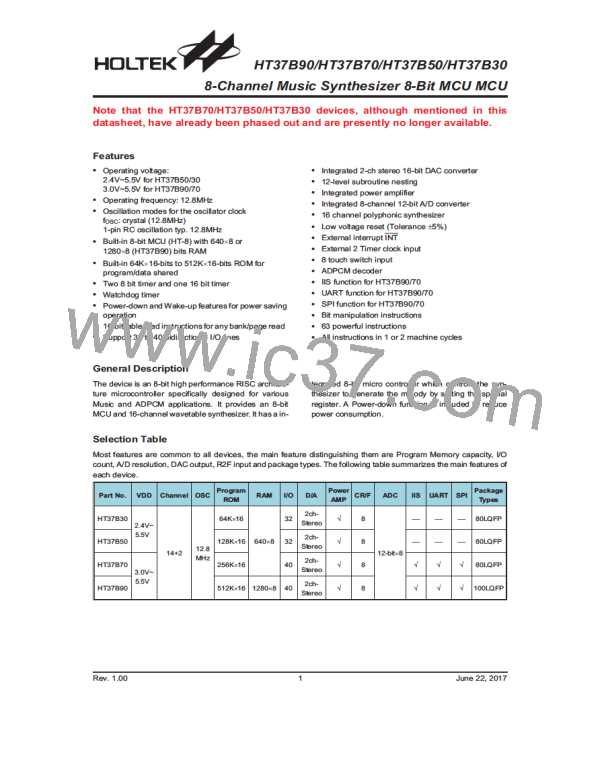HT37B90/HT37B70/HT37B50/HT37B30
Input/Output Ports and Control Registers -
the end code (80H) until the volume become close. It
provides the left and right volume control independently.
The 10-bit left and right volume are controlled by ENL,
LVC and RVC respectively. The ENV contain both left
and right volume some bit of high byte.
PA, PB, PC, PD, PE, PAC, PBC, PCC, PDC, PEC
Within the area of Special Function Registers, the I/O
registers and their associated control registers play a
prominent role. All I/O ports have a designated register
correspondingly labeled as PA, PB, PC, PD and PE.
These labeled I/O registers are mapped to specific ad-
dresses within the Data Memory as shown in the Data
Memory table, which are used to transfer the appropri-
ate output or input data on that port. with each I/O port
there is an associated control register labeled PAC,
PBC, PCC, PDC and PEC, also mapped to specific ad-
dresses with the Data Memory. The control register
specifies which pins of that port are set as inputs and
which are set as outputs. To setup a pin as an input, the
corresponding bit of the control register must be set
high, for an output it must be set low. During program ini-
tialization, it is important to first setup the control regis-
ters to specify which pins are outputs and which are
inputs before reading data from or writing data to the I/O
ports. One flexible feature of these registers is the ability
to directly program single bits using the ²SET [m].i² and
²CLR [m].i² instructions. The ability to change I/O pins
from output to input and vice versa by manipulating spe-
cific bits of the I/O control registers during normal pro-
gram operation is a useful feature of these devices.
ADPCM Function Registers -
ADR, XSPL, XSPH, ADPC, ADPS
HT37B90/70/50/30 contains ADPCM Decoder Func-
tion. The must set initial value of register known as
XSPL and XSPH before implementing ADPCM Decoder
procedure. There are two 4-bit ADPCM encode data of
ADR. The data of ADR implement via ADPCM Decoder,
and output 8-bit PCM data which is synthesized by MIDI
synthesizer.
The ADPC is the control register for the ADPCM De-
coder. The ADPS is the status register for the ADPCM
Decoder.
CR/F Converter Registers - ASCR, TMRAH, TMRAL,
RCOCCR, TMRBH, TMRBL, RCOCR
There are 8 analog switch lines in the microcontroller for
K0~K7 for HT37B90/70/50/30 Analog Switch control
registers known as ASCR. The RC oscillation converter
contains two 16-bit programmable count-up counters
and the Timer A clock source may come from the sys-
tem clock (fSYS=fOSC/2) or system clock/4 (fOSC/8). There
are two data registers, a high byte data register known
as TMRAH, and a low byte data register known as
TMRAL. The timer B clock source may come from the
external RC oscillator. There are two data registers, a
high byte data register known as TMRBH, and a low
byte data register known as TMRBL. There are two con-
trol and status registers known as RCOCCR and
RCOCR.
D/A Converter Registers - DAH, DAL, DACC
HT37B90/70/50/30 provide two 16-bit D/A converters,
which can select stereo or mono output. The correct op-
eration of the D/A requires the use of two data registers,
and a control register. It contain a 16-bit D/A converter,
there are two data registers, a high byte data register
known as DAH, and a low byte data register known as
DAL. These are the register locations where the digital
value is placed before the completion of a digital to ana-
log conversion cycle. The configuration of the D/A con-
verter is setup via the control register DACC.
A/D Converter Registers -
ADRL, ADRH, ADCR, ACSR
HT37B90/70/50/30 contains a 8-channel 12-bit A/D
converter. The correct operation of the A/D requires the
use of two data registers, a control register and a clock
source register. It contain a 12-bit A/D converter, there
are two data registers, a high byte data register known
as ADRH, and a low byte data register known as ADRL.
These are the register locations where the digital value
is placed after the completion of an analog to digital con-
version cycle. The channel selection and configuration
of the A/D converter is setup via the control register
ADCR while the A/D clock frequency is defined by the
clock source register, ACSR.
Wavetable Function Registers - CHAN, FreqNH,
FreqNL, RepH, RepL, ENV, LVC, RVC
HT37B90/70/50/30 contains Wavetable synthesizer
Function. The HT37B90/70/50/30 has a built-in 16 out-
put channels. CHAN is channel number selection.
FreqNH and FreqNL are used to define the output
speed of the PCM file.
AddrH and AddrL is setup for the start address of the
PCM code before Wavetable function implement. The
repeat number register as known RepH and RepL are
used to define the address which is the repeat point of
the sample. When the repeat number is defined, it will
be output from the start code to the end code once and
always output the range between the repeat address to
Rev. 1.00
20
June 22, 2017

 HOLTEK [ HOLTEK SEMICONDUCTOR INC ]
HOLTEK [ HOLTEK SEMICONDUCTOR INC ]